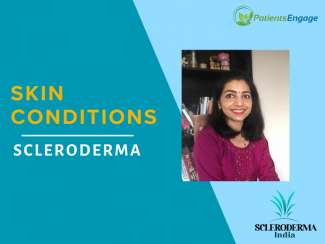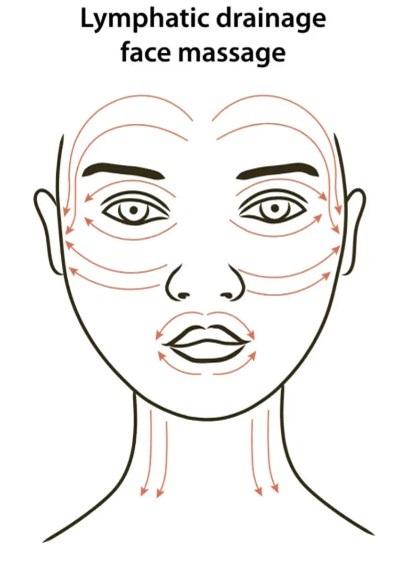
Dr Aarya Sree, Consultant dermatologist talked about skin conditions affecting patients with Scleroderma and how they could manage them. She explains in detail how Scleroderma affects the skin. With various products and cosmetic procedures available in the market, Dr Sree clarifies what can or cannot be used or undertaken and why. This session was part of the Sclerocon e-conference held in June 2023.
Scleroderma is a multi-organ disease where sclero means hard and derma means skin. However, it not only affects the skin but also other internal organs like heart, lung, kidney and sometimes bone. Basically, our immune system becomes overactive causing hardening and thickening of the skin, as the body will produce a lot of collagen. Normally, collagen is high at birth so that's why the baby's skin looks very soft and pliable but when you go to the 20s and 30s, it become bits firm. Once you reach the 60s and 70s, the collagen starts degrading and skin starts sagging and wrinkles start appearing. But in Scleroderma the autoimmune body is producing lots and lots of collagen, much more than needed and this collagen gets accumulated in the skin. Skin has three layers the upper (epidermis), second (dermis) and third (subcutaneous). The collagen will deposit in the second part or dermis and that is why the skin is getting hard. Once the collagen starts getting laid out late in the dermis, there will be loss of wrinkles followed by the loss of fat. There will be a change in the facial contour of this patient and there will be mask-like face with limited facial expression, difficulty closing mouth, dryness of skin and fissures. Patient cannot close or extend their hands properly.
Full video available here: https://www.youtube.com/watch?v=xyZ_b3W5XBs
How does Scleroderma affect the skin?
- Almost 80 to 90% of Scleroderma patients have some skin changes mostly hardening of the skin, which might start from the tip of the fingers and progressively involving other areas. When only some part of the body is affected, it’s called morphea.
- Thickening of skin leads to non-functioning sweat glands and there will be associated decrease in the oil glands, therby increasing the drying effect.
- Many have salt and pepper pigmentation.
- Digital ulcers are formed because of the Raynaud’s phenomena, which are very painful and do heal with scarring.
- Red spots or telangiectasis
How is Sclerodermal skin disease treated?
- Medicines methotrexite or MMF, as prescribed by your Rheumatologist.
- Exercises to release the tightening and give some mobility to your small joints. Simple exercises like moving the hands using a softball.
- Physiotherapy using warm paraffin/wax bath to reduce pain. After pain relief, you can simply start small exercises that should be done under the supervision of a physiotherapist. If this service is not available, you can do a liquid paraffin at home. Apply this liquid paraben or any oil which is not irritating all over the hand and put hand in lukewarm water. The water should not be too hot or too cold.
What should be the skin care routine in a usual day?
On a daily basis, only three basic things should be used by a person with Scleroderma:
- good cleanser
- good moisturizer
- good sunscreen
Which is the best moisturiser to use?
There is no best moisturizer, use what you like. Some people like more greasier ones because their skin is very flaky or dry. Those who don’t have that problem can go for less greasier ones. like cream or lotion. Better go for a paraffin free, hypoallergic and fragrant free product because the fragrance or the parabens can cause an allergic reaction to your face or your eyelids, which are sensitive areas.
When to apply moisturizer?
Before going to bathe, apply any oil all over your body, wait for 10 minutes then take a lukewarm water bath or shower. Water should not be very hot because, it will dry your further. Also avoid long showers (more than 5 minutes) for the same reason. Use mild soap with low alkaline content (pH should be at around 5.5), because high alkaline content can again cause dryness. Alkaline soaps of ph 7 or 8, are the most commonly available soaps in our market After the bath, apply within a seconds while skin is still wet adequate amount of moisturiser. Apply twice or thrice a day depending on your convenience but at least twice to improve your dryness. If tightness in hands makes it difficult to apply moisturisers, use a brush or squeeze moisturisers into a container for easy application. Always apply in the downward direction towards the direction of your feet. Upward movements can cause occlusion folliculitis, which is hair follicle infection, with pustules.
Apply a sunscreen that does not irritate your skin. When buying a sunscreen, check the sun protection factor or SPF to ensure it is no less than 30. This will give you adequate amount of protection. Apply sunscreen 20 or 30 minutes before going out and this give you the protection up to two to three hours. If you are having any sunburn, better to reapply after two to three hours.
Can face serums be used?
Yes, basically face serums contain antioxidants, most have vitamin C. Different brands are available over-the-counter or from cosmetic shopping sites. As far as benefits go, antioxidants are less harmful unless it irritates your skin. Sometimes face serums will be oily, and provide moisturize to your skin. There is no surety that this will reduce pigmentation but will help to reduce it a bit. Serums with salicylic acid serum work to reduce the oiliness of the skin and are not advisable for Scleroderma patients. Collagen based serums and cream have no evidence to on whether they will activate your disease or improve your skin, so are best avoided. Additionally, collagen is a very big molecule which will have very less penetration through the skin to cause any change.
Causes of skin itching and how to manage it?
This is a common problem that people have with very itchy or severe pruritis. Dryness occurs because the skin is getting hard and not getting enough moisturizer. Decreased oil glands in the skin will cause a lot of dryness. Tackle this by applying good amount of moisturizer twice or thrice in a day. If your itching is not getting subsided, and you feeling that your thickening is increasing or it's progressing, then have a chat with your Rheumatologist. It might be that your disease is getting active in which case, you need to treat the disease by medical management (pharmacological therapies).
Systemic causes like low thyroid can cause dryness so need to check the thyroid function. Iron deficiency which occurs as a consequence of fibrosis involving the gastrointestinal tract so you may not get enough nutrition, can also lead to dryness.
If itching is causing sleep disturbances, use antihistamines like cetirizine or fexopenidine for relief.
For scalp itching, apply some good oil or cream; keep this cream in the fridge so it provides a cooling effect on application. However, if you have Raynaud’s phenomenon or digital ulcers, use gloves to use creams from the fridge.
What is telengiectasia and how to manage it?
Telengiectasia or red spots occur when the tiny blood vessels on the skin get dilated and become visible. Commonly seen on the face, hands and legs. While it is seen in scleroderma, if you feel like it is becoming more, inform your rheumatologist as this might be an early predictor of the pulmonary artery hypertension or lung problem. This may not respond to medication but camouflaging with makeup products like concealer or foundation is helpful. One can opt for vascular lasers like IPL or PDL, which are very effective. Remember these treatments can treat whatever it is in your face or your hands, but cannot stop them from occurring. Some patients have calcinosis that are calcium deposits. Carbon dioxide laser has been tried and showing good results.
Is massaging useful?
Yes, it's a very good thing that you can do it even at home. Can be done while watching TV, or reading at any time, any place. Besides relaxation, it will improve the mobility of the joints and help drain the excess fluid in the face because sometimes steroids or immunosuppressants can cause puffiness. Massaging with a moisturizer or oil decreases the dryness, itching as well as the puffiness. During facial massaging, see image to know how to massage towards the area where the lymph nodes are draining. Lymph nodes are glands which is present in different parts of the body which will drain our excess fluid from the tissues.

Is it okay to do Salon procedures?
Cosmetic appearance is a big issue in Scleroderma and many patients would like to address their dryness or reduce pigmentation etc. Facial is a good salon service because it involves cream application, face massage. Avoid products that feel sensitive and irritating. Say no to bleaching because it contains ammonium or other bleaching agents which might give you an instant glow or lightening but this will only last one or two days. When you expose to the sunlight or when the skin start rejuvenating it can cause irritation. Peeling is now available in clinics and salons and can be good if it is only dealing with the upper part of the skin. But deep peels like cosmelan peels or tricyclic acid (TCA) peels can affect the your upper and lower part of the skin causing burns, irritation, inflammation and pigmentation. In pedicure and manicure, they are mainly dealing with the nail. If have Raynaud’s phenomenon or when you have skin thickening you might have some defect in your nails. When they do the manicure or pedicure, they tell you they are removing the debris but they are actually removing the connection between the proximal nail and the nail fold. If they remove that part, there is a a gap between the nail and the skin, which is exposed during cooking or washing and allergens like soaps or detergents can cause irritation and even fungal infections (since you may be on immunosuppressants). Hence, it's always better to avoid pedicures and manicures.
What are Callosities?
Callosities is formation of callus (thickened skin with kearatin that looks yellowish) esp on toes due to loss of fat. It causes excruciating pain on walking or pressure. Consult your dermatologist because they can suggest wearing soft padded chapels or shoes that normalize the pressure over that area. Salicylic acid containing cream (16-25%) should be applied over that area only at night. Cover that area with plaster but remove it the next morning. After 15 to 16 days, the skin starts peeling at which time, use a pumice stone while bathing to gently scrub that area and get rid of the dead skin. Silicone pads can also be used.
What are digital ulcers & fissures?
Digital ulcers and fissures are mainly due to the Raynaud's disease, which if treated optimally either via oral drugs or IV injections can be prevented. Ulcers and fissures can be prevented by :
- warming hands and legs with sweaters, gloves and socks to make your core body temperature warm.
- Drinking warm tea when going out in winters.
- try not to go out much.
If you have developed cracks or ulcers but have no pain, pus or fever then it is not infected but if these symptoms exist, there might be infection. In that case, consult with your doctor and start on antibiotics. If the ulcers is not healing after completion of antibiotic course, you can use zinc oxide paste which is commonly available. Another problem is fissure foot and severe dryness that happens on the heel of the foot. For lip chapping use a good lip balm regularly, sometimes every hour or every two hours.
How can pigmentation be managed?
Difficult to tackle because diffuse pigmentation means it's all over the body or it could be salt or pepper pigmentation mainly in this upper chest area, back, forehead, behind ears or over the scalp. Mainly this pigmentation is a consequence of inflammation. Once inflammation stops in your body, your skin starts getting pigmented because all the inflammatory cells start subsiding. In some people it improves very slowly but in some it persists. If it’s on the face, foundation or concealer or camouflaging makeup can be used. Your dermatologist will give you a sample pack of foundation, which you can test to see which best suits your skin colour.
We have lot of cosmetic procedures available now like injectable fillers (can be synthetic or collagen fillers or fat transfers or botox. Fillers are a good option like if your disease is stable, you with no further increase in the skin thickening and your lung functioning is fine. Fat transfer is useful only in inactive diseases and studies has shown that they have not seen any reactivation in the stable diseases, but it's only decided when you have a chat with your Physician. Fat transfers are more beneficial than fillers, as fillers only last for 2 years or less. sometimes around one to uh 12 to 18 months. In fat transfer, your own fat (autologous) is transferred which is usually done by a plastic surgeon. It is much more beneficial than fillers but is quite expensive. Maximum benefit is around the cheek and mouth and less over the chin area. You might need 2 or 3 sessions as one session may not give complete correction of the face. Improvement in the pain, cosmetic appearance and mouth opening is seen.
Fillers are more affordable. People whose disease is stable and are on immunosuppressants can opt for this procedure. 1 or 2 sessions may be needed. There are different types of fillers, most extensively studied one is the hyaluronic acid filler. Patients lose a lot of volume over the face like over the cheek, chin and perioral area. When you inject this hyaluronic acid, it forms like a gel and will hold the water to restore the volume. We are not sure how long it will last, in normal cases it will last around 18 months but Scleroderma cases it may last only up to 12 months.
Botox is not useful because botox is used to decrease the tension due to wrinkles. In Scleroderma, the skin is already very tight.
If patients has a lot of ulcers or loss of tissue, a plastic surgeon can help with the skin/ cartilage graphs, tissue expanders, or flaps to change the appearance. Always consult your doctor before going for any procedure so he/she can guide you.

Dr. Aarya Sree is a consultant Dermatologist
Note: This is a loosely edited text of the presentation made by Dr. Aarya Sree at the Sclerocon 2023 conference






